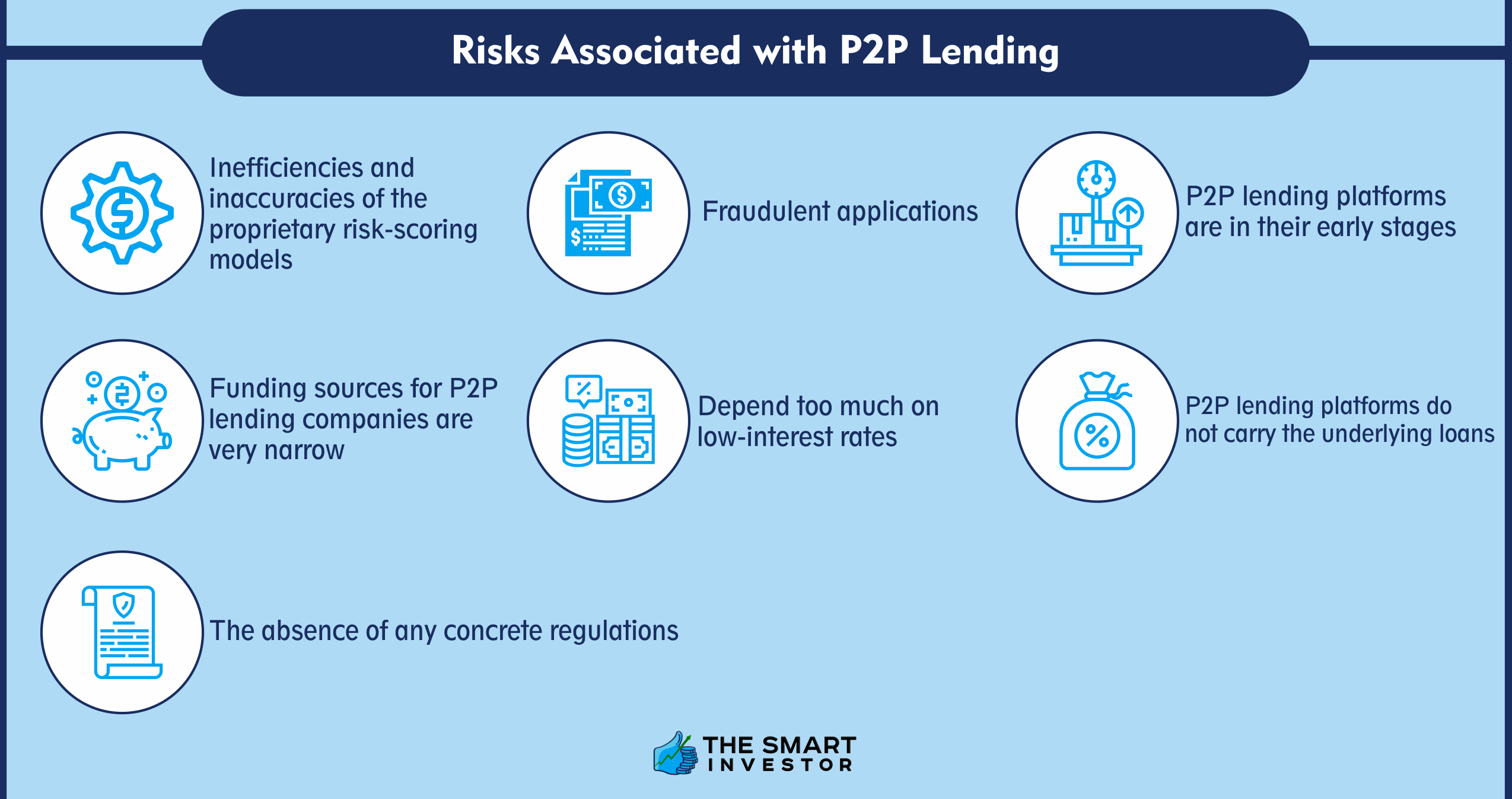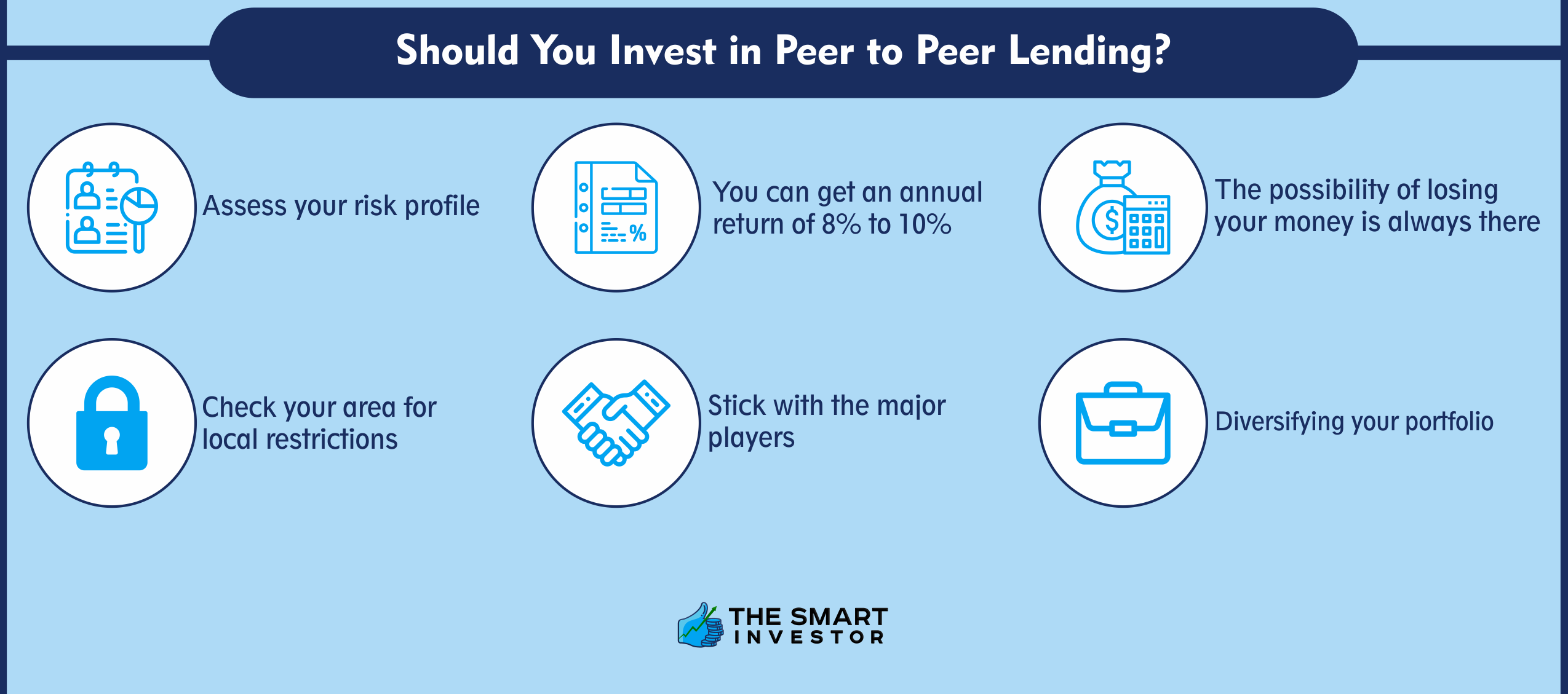Table Of Content
Investors have been making a beeline towards peer-to-peer lending. Peer-to-peer (P2P) lending became popular because it gives consumers an opportunity to borrow money without having to apply with a bank or a credit union.
Borrowers, likewise, are rushing to peer-to-peer lenders for financial needs and snubbing the traditional lenders like banks and financing companies. Investors who want to diversify their portfolio are also using peer-to-peer lending as part of their investment mix.
Technically, a P2P “lender” isn't actually lending money themselves; they're more like an entity that provides the platform and facilitates the lending process. These platforms are growing in countries like the US, UK, Australia, and other major financial markets, but the United States still leads the way in peer-to-peer lending.
But how does it really work? Is it wise to invest in it?
What is P2P Lending
P2P loans come from individuals and investors – they do not come from banks like in a traditional loan.
Peer-to-peer lending is much like lending money to family and friends but in a more expansive industrial setting that uses P2P websites to match lenders with borrowers for a win-win situation.
It’s simply people with extra money offering to lend to individuals and businesses that are in need of cash.
Since the entity needing the money does not know the one who is willing to lend, a P2P service stands as the middleman to hook them up together. By using modern technology, the process becomes simple, safe and efficient.
Lenders are merely savers who are looking for a slightly higher return on their money while the borrowers are individuals or companies who are looking for a cash infusion. Of course, the borrowers should be able to pass diligent checks to make sure they have the capacity to pay back the loan.
How Does P2P Lending Work?
Although each P2P website may have a different process, the P2P lending activity usually follows these steps:
- A loan applicant submits an online application to the P2P platform for evaluation. At this point, the website will not yet post the loan request.
- The platform secures a credit report on the applicant and other relevant data (e.g. loan characteristics) to use them for grading purposes. P2P websites use their own proprietary models to determine risk grade and set loan interest.
- If the borrower qualifies, the platform posts a loan request with some details on the P2P website. Investors can review these postings or search for specific loans that meet their requirements in terms of risk level and rate of return.
- If the request gets enough investors to fund it, a bank (originating bank) will then originate the loan. These banks insure their deposits with the Federal Deposit Insurance Corporation (FDIC). Note that the platform will divide a single loan into several chunks to allow more investors to participate. Doing so helps the investors diversify their portfolios and distributes the risk of default among several investors.
- The originating bank sells the notes associated with the specific loan to the platform. The P2P platform then sells the note to each lender that has committed to fund the loan according to their share of the principal. The P2P issues the note per borrower and some investors can register some of these notes with the Securities and Exchange Commission (SEC).
- The notes that the platform issues (also known as “borrower payment dependent notes”) rest on the underlying loan. This means that the investors can only receive payment from the platform if the underlying borrower repays the loan.
- The platform collects a fee on the loan, including origination and servicing fees, before releasing the remaining proceeds to the borrower.
P2P Lenders: Requirements, Benefits and Risk
You will notice that there are more and more P2P lenders sprouting in the market. Two pioneering sites ignited the popularity of the concept – Prosper and LendingClub – both of which are still active and doing well in the P2P arena.
P2P Lending Minimum Investment
Note that we are only focusing on Prosper and LendingClub for the simple reason that they are the two biggest P2P lending companies at present. If you want to invest at any of them, you only need $25 to start, but you need to invest a minimum of $25 into each loan you want to fund. Both companies collect an annual fee of one percent from their investors.
These two P2P sites let you choose to invest via a traditional taxable investment account or via an IRA tax-deferred investment account.
Keep in mind that the Securities and Exchange Commission (SEC) has set some basic requirements for P2P lending. These include a minimum gross annual income of $70,000 and a minimum net worth of $70,000. This applies to most states, but in California, both the income and net worth minimums are $85,000.
P2P Lending Requirements
You must be a resident of an approved state. Currently, residents from all states are eligible for P2P investing except the following 5 states: Arizona, New Mexico, North Carolina, Ohio, and Pennsylvania.
If your net worth is at least $250,000, you can enjoy an exception to the minimum annual income requirement.
If you want to know the specific requirements to invest as a P2P lender, you can visit the individual P2P lending sites and check their Investor Page. Mostly, the process will be as simple as opening an account, depositing your opening balance, and reviewing potential borrowers.
Some marketplace lenders are quite selective on who can invest in their loans, so they place certain restrictions. Some companies like LendingClub and Prosper, are friendlier to everyone as long as you meet the minimum requirements.
Other sites accept only accredited investors and qualified purchasers. Accredited investors are those who have a personal income of $200,000 ($300,000 for joint) for the last two years or those who have a net worth exceeding $1 million, individually or jointly.
To be a qualified purchaser, one has to have at least $5 million in investments, a much bigger requirement than for accredited investors. Lastly, you can find some P2P lenders that accept only institutional investors such as commercial banks, hedge funds, pension, or endowment funds and life insurance companies.
Advantages of P2P Lending
Investors are choosing P2P lending as an option because they see that it offers advantages to both borrowers and investors.
Here are some advantages to the borrowers:
- Lower loan interest rates compared with traditional loans from bank credit cards or installment loans.
- Make their transactions in the easy-to-use online interface.
- They are well-informed because of the transparency of the platforms through uniform and clearly disclosed loan terms.
- Borrowers enjoy an efficient decision-making process because of the technology that quickly assesses and assigns risk grades and interest rates to loan applicants.
Here are some advantages to investors:
- Receive high risk-adjusted returns for their money.
- Investors can now invest in a high yield investment class that was traditionally only for institutional investors, for as low as increments of $25.
- Investors can choose and pick the loan to fund because of the transparency and autonomy that the P2P companies provide, as well as monitor loan performance in real-time.
- They have quick access to credit profile data for each loan they approve.
P2P lending platforms have a lower cost than traditional lenders because they maximize the use of technology in their business. In fact, you may look at what they are doing as a form of securitization where, through automation, they divide individual loans of individual borrowers into notes they subsequently issue to numerous investors.
P2P saves a lot of operating costs because they do not have to maintain a physical branch network to service clients and investors. But perhaps the biggest cost saver is that neither the P2P platforms nor the originating banks do not carry the P2P loans on their books. This exempts them from complying to bank capital requirements.
Risks Associated with P2P Lending
Although P2P lending might score appreciable advantages for both investors and borrowers, it is not without imperfections. For one, investors assume more risks than borrowers in a P2P setting. Borrowers can still enjoy the protection that the law provides – including usury laws and regulations against unfair collection practices, misleading advertising, and discriminatory actions. Likewise, since we are talking about lending, P2P investors also open themselves to borrower credit risk, interest rate risk, liquidity risk, and regulatory risk.
P2P investors can also face the following risks incidental to P2P lending:
- There could be inefficiencies and inaccuracies of the proprietary risk-scoring models of P2P platforms.
- There is a probability of fraudulent applications because of the faceless and paperless process of Internet lending.
- The P2P lending platforms are in their early stages and have a limited operating history.
- The funding sources for P2P lending companies are very narrow, so this limits diversification.
- P2P lending platforms depend too much on low-interest rates to service high transaction volumes.
- P2P lending platforms do not carry the underlying loans they facilitate on their balance sheet, unlike traditional lenders.
- The P2P platforms do not assume any repayment responsibility to their investors if borrowers default on the underlying loans.
- The absence of any concrete regulations to oversee the P2P lending industry (we will discuss this “regulatory purgatory” in more detail below).

Borrower Default Scenario
If you look at their business model, P2P lending platforms make money when they originate and service loans but they assume no risk in case the borrowers default on their loans.
They only pay the investors if the borrowers make a payment on the underlying loans.
Get this: even in case of default and collection, P2P platforms still collect fees.
If a borrower defaults, the P2P platform contracts a collection agency to recover the money. For any amount that the collection agency recovers, the P2P platform will charge a servicing fee, so the respective investors do not get their full share.
However, to mitigate borrower credit risk, P2P lending platforms have taken steps such as providing credit scores for each borrower, offering collection services for errant borrowers, and providing diversification through the purchase of fractional loans.
Should You Invest in Peer to Peer Lending?
The first step is to assess your risk profile. Realistically, you can get an annual return of 8% to 10%, but the possibility of losing your money is always there. So, if you can’t afford to lose a big chunk of the principal you will invest, it’s better to skip investing in P2P lending.
Second, check your area if they have local restrictions. For example, certain states like Ohio ban peer-to-peer lending because the state government believes that the risk of loss and outright fraud do not justify the potential benefits.
However, if you really want to venture into peer-to-peer lending, we suggest you stick with the major players who are transparent about their process and have impressive track records. Established groups like LendingClub and Prosper now share the limelight with firms like FundingCircle and Upstart.
They share a registration with the U.S. Securities and Exchange Commission and each one employs sophisticated tools to gauge the risk of potential borrowers. Although those things do not guarantee 100% success for your investment in P2P lending, they can help lessen some of the risks of default.
Lastly, never forget the importance of diversifying your portfolio.
If you want to invest in peer-to-peer lending, just make sure it’s only a part of your portfolio.
And instead of lending $10,000 to one person, consider breaking it up for various borrowers. Ten smaller loans of $1,000 per borrower is a good strategy to spread out your risk and lessen the impact in case one or two borrowers default on their loans.

